*FYI - this post may contain affiliate links, which means we earn a commission at no extra cost to you if you purchase from them. Also, as an Amazon Associate I earn from qualifying purchases. Check out our Privacy Policy and Disclosure for more info.
Chinese New Year is a special time of year filled with family bonding, endless superstitions, and (for me), eating a boat load of dumplings for the sake of future wealth.
And with a culture as food-centric as China’s, you can definitely expect plenty of incredible foods to gorge on during the year’s most important holiday.
If you’ve ever wondered what foods are considered typical Chinese New Year foods, what the “luckiest” Chinese New Year dishes are, and (for those who dare), are looking for some unique Chinese New Year recipes to try, then read on.
Below, you’ll find a list of Chinese New Year foods that are sure to guarantee prosperity, wealth and food comas.
First: The Complexity of Finding “Authentic” Chinese New Year Dishes
When putting together this list of traditional Chinese New Year food, I (as most children of immigrants do) turned to my parents for their eternal wisdom.
Their first reaction went along the lines of “what do you mean ‘traditional’ food?”, followed by what I can only describe as a silent existential crisis.
The difficulty my parents had with answering what I thought was a straightforward question boils down to a few factors: first of all, traditional Chinese New Year dishes vary greatly based on region. What they consumed growing up in the South of China differed greatly from Chinese families elsewhere, which means it’s tough to generalize what’s typical for Chinese New Year across the country.
Secondly, they immigrated to Canada in their early 20s, and Chinese New Year dishes/celebrations in North America differ from China as well, just as Westernized Chinese cuisine differs from more traditional Chinese dishes.
Lastly, the celebration of Chinese New Year is a personal thing that varies even family to family. Just as most families vary in what they serve for Christmas dinner, the same is true for Chinese New Year. What you might consume at a New Year’s banquet in China would differ greatly from a home-cooked Chinese New Year meal among close family.
So, while browsing the list of Chinese New Year foods below, keep in mind the following:
- What is consumed on Chinese New Year differs by region and even family
- Chinese cuisine is so diverse and varied that what’s considered “traditional” or “authentic” depends greatly on where you are
- Many older Chinese New Year traditions have been lost over time
- Chinese New Year celebrations have evolved and morphed a great deal thanks to the Chinese diaspora found all over the world
To cap off my mini food-related existential crisis, at the end of the day, what matters most with Chinese New Year dishes (in my opinion anyway) is that they taste good.
If you’re preparing your own Chinese New Year feast at home, rather than worry about THE most authentic Chinese New Year dishes or recipes, I would recommend adapting some of the lucky and symbolic foods below to your own tastes.
… Of course, I’ll be providing some recipes to guide you along the way!

Traditionally “Lucky” Chinese New Year Foods According to Superstition
If we were to speak in broad strokes about the kinds of food that is served on Chinese New Year, there are some dishes that are considered universal symbols of prosperity, fortune, and all that good stuff we wish for in the New Year.
Here are a few of the most popular Chinese New Year foods you’ll commonly see.
Dumplings
Dumplings symbolize wealth thanks to their shape, which resemble yuanbao – Chinese gold ingots.
It is said that the more dumplings you eat during Chinese New Year, the wealthier you’ll be… which sounds like a pretty excellent excuse to eat endless dumplings to me.
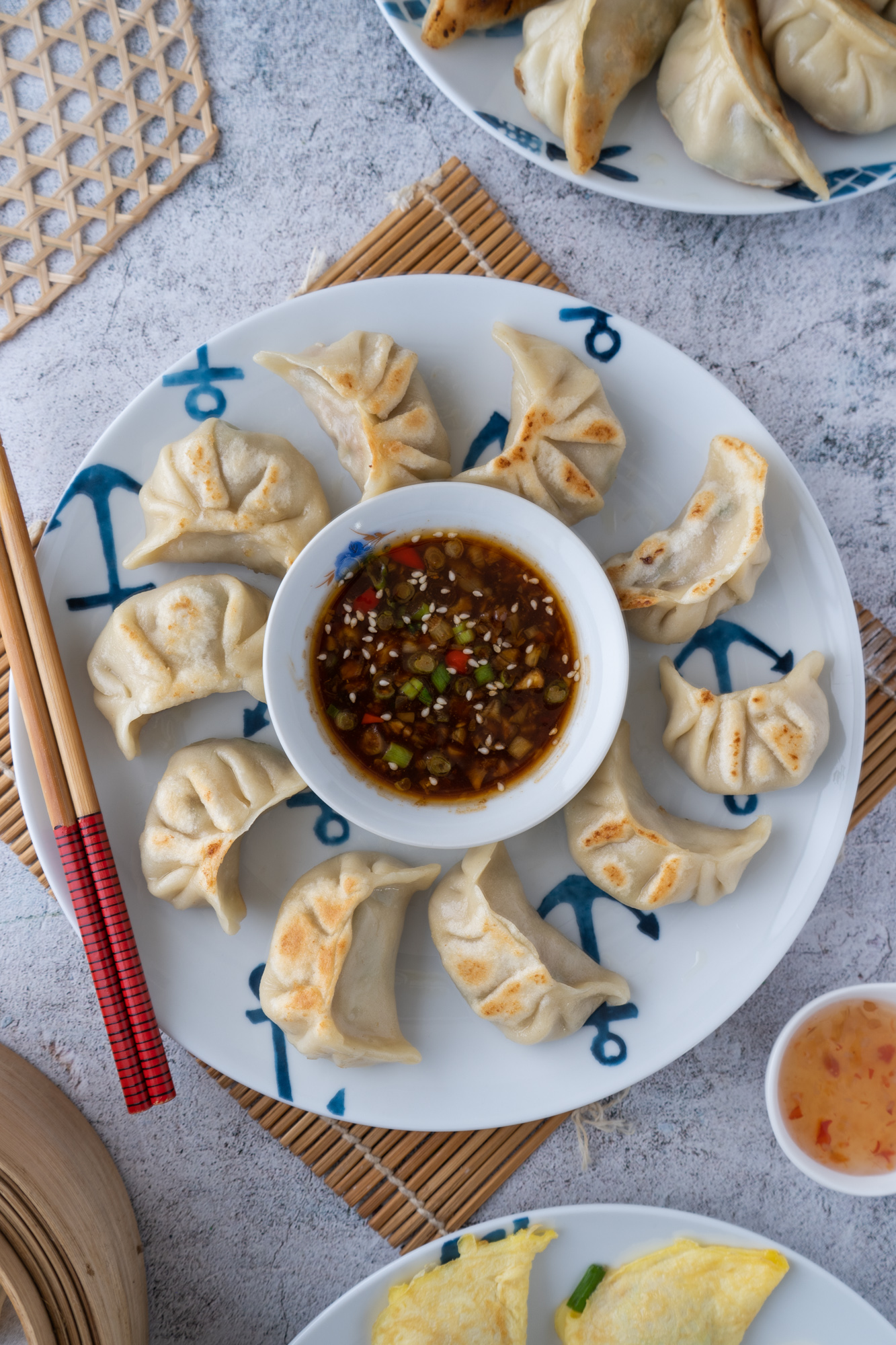
Tangyuan
Another type of dumpling that’s popular in some parts of China for Chinese New Year is Tangyuan, which take on savory and sweet variations.
The name “Tangyuan” sounds similar to a Chinese phrase which translates loosely to togetherness and family gathering, hence why it’s such a popular staple of Chinese New Year menus, particularly on the last day of Chinese New Year.
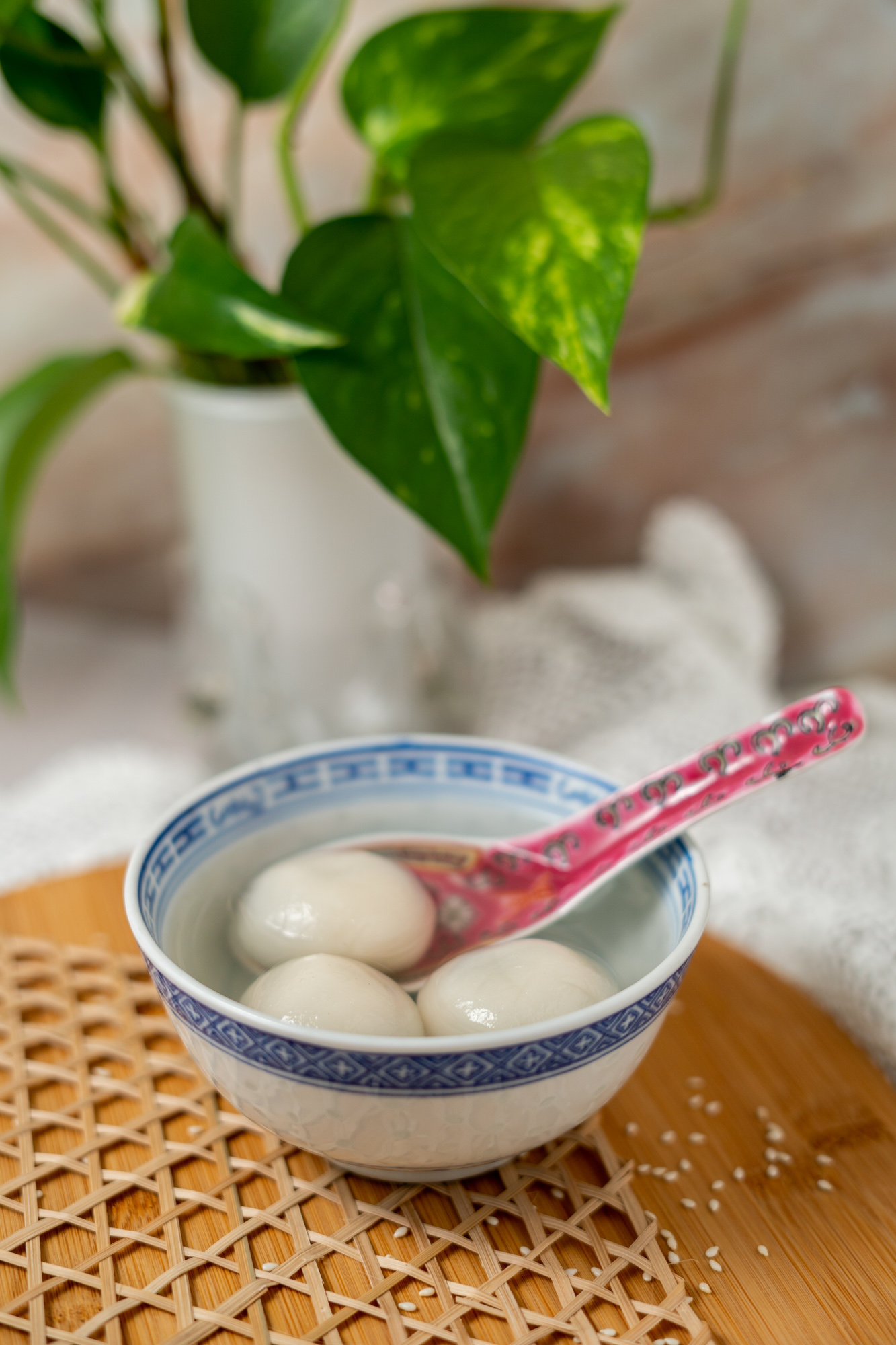
Spring Rolls
Just as dumplings resemble gold ingots, spring rolls resemble bars of gold, so unsurprisingly, spring rolls are also considered symbols of wealth that are especially popular to eat and serve at Chinese New Year.
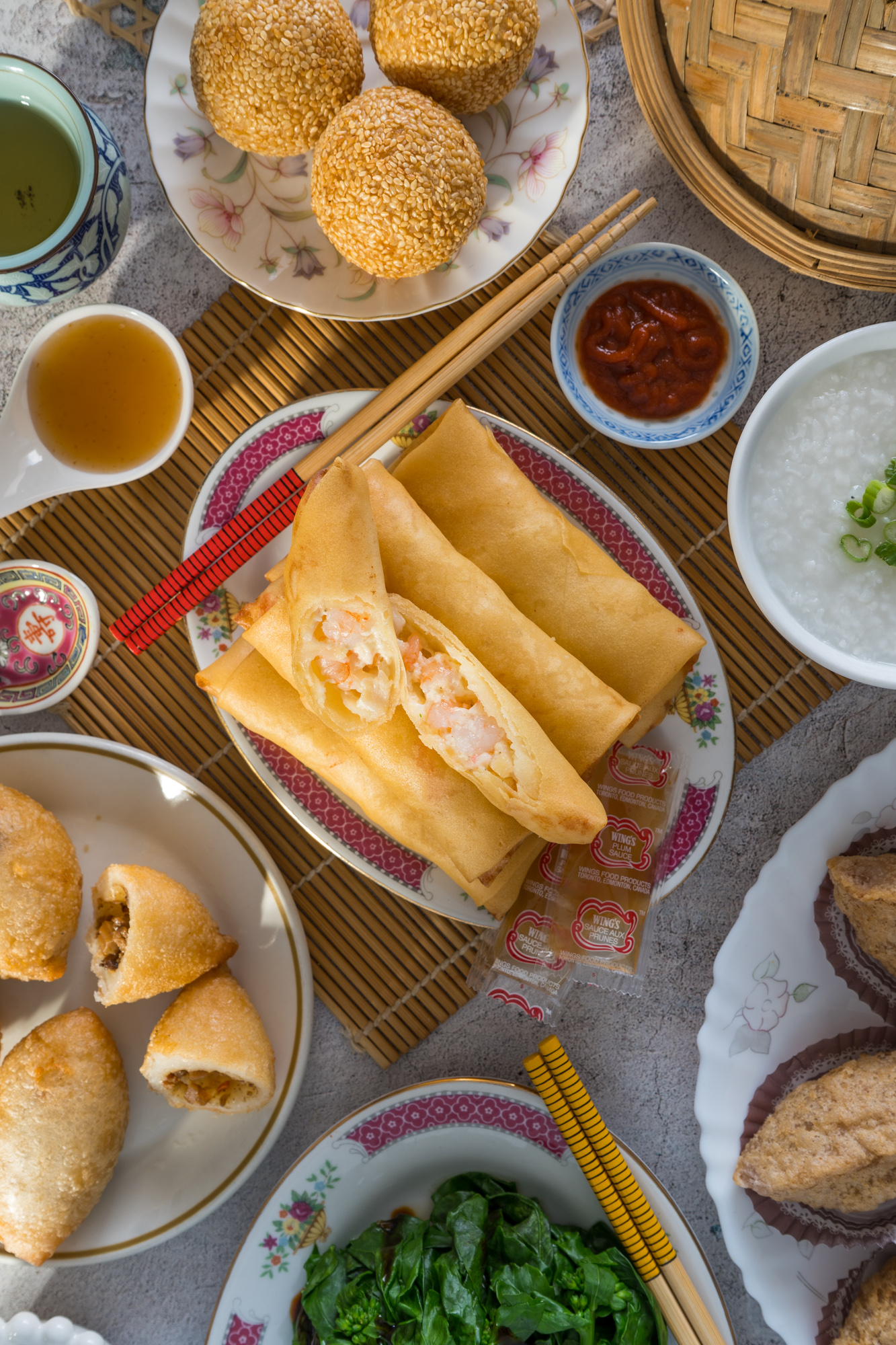
Citrus Fruits
Chinese New Year is always a chaotic time around the house because I find oranges and mandarins literally everywhere I go.
Why are citrus fruits so popular for Chinese New Year?
As with many other items on this list of popular Chinese New Year foods, the answer comes down to symbolism and wordplay.
As per southern Chinese tradition for example, mandarins are popular because in Cantonese, their name sounds like gold, which (you guessed it) symbolizes wealth and future fortune.
Oranges carry a similar reputation of good luck and auspiciousness, as does the giant Chinese grapefruit, which sounds like the Cantonese word for “to have”.
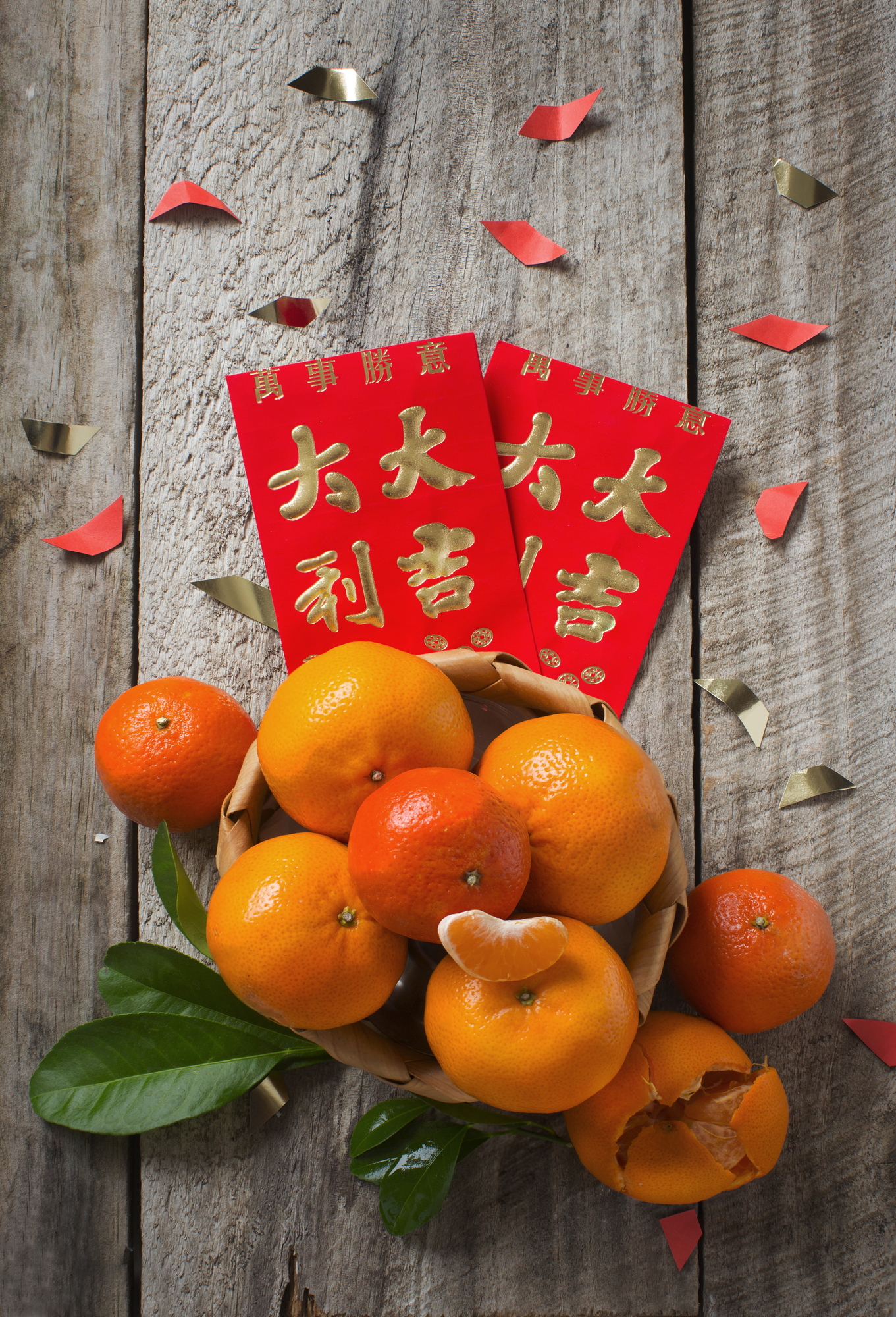
Nian Gao
Many lucky Chinese New Year foods involve wordplay and puns.
In the case of Nian Gao, the name alludes to things increasing/getting higher in the year, so think higher salary, higher income, higher height (for kids) and positive increases all around.
NOTE: Nian Gao can refer to a few different dishes, from the savory rice cakes beloved in Shanghai to the sweeter variations eaten in the South.
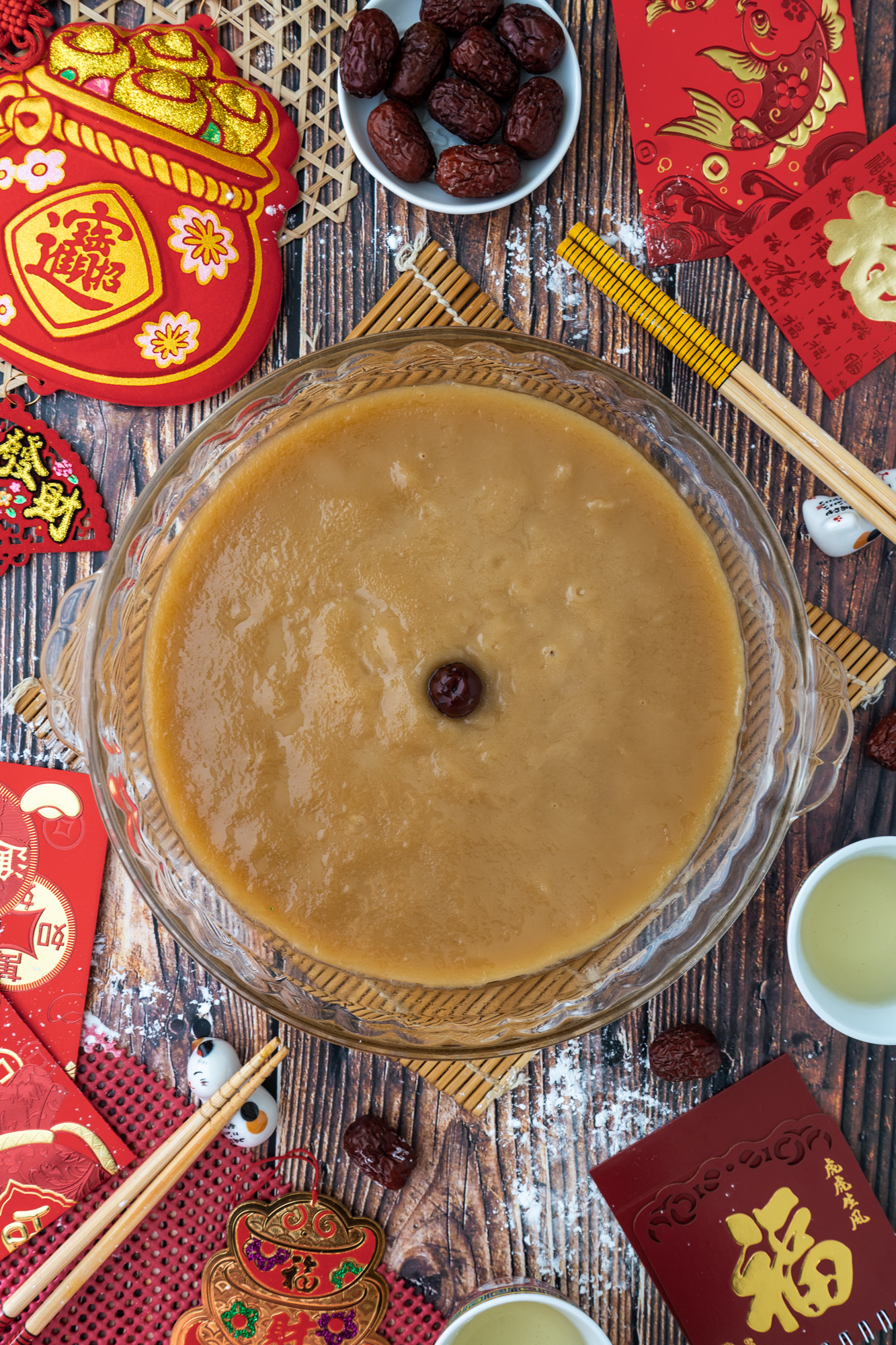
Longevity Noodles
Noodles are a staple of Chinese cuisine any time of year, but extra lengthy noodles (also known as longevity noodles) are especially popular during celebratory occasions such as birthdays and of course, Chinese New Year.
These long noodles symbolize a long and prosperous life, which make them a no-brainer to add into any Chinese New Year menu.
IMPORTANT: Noodles during birthdays and Chinese New Year should be slurped and eaten in a way that the noodles don’t break, because breaking noodles can be a bad omen (i.e. you’re cutting your life short).
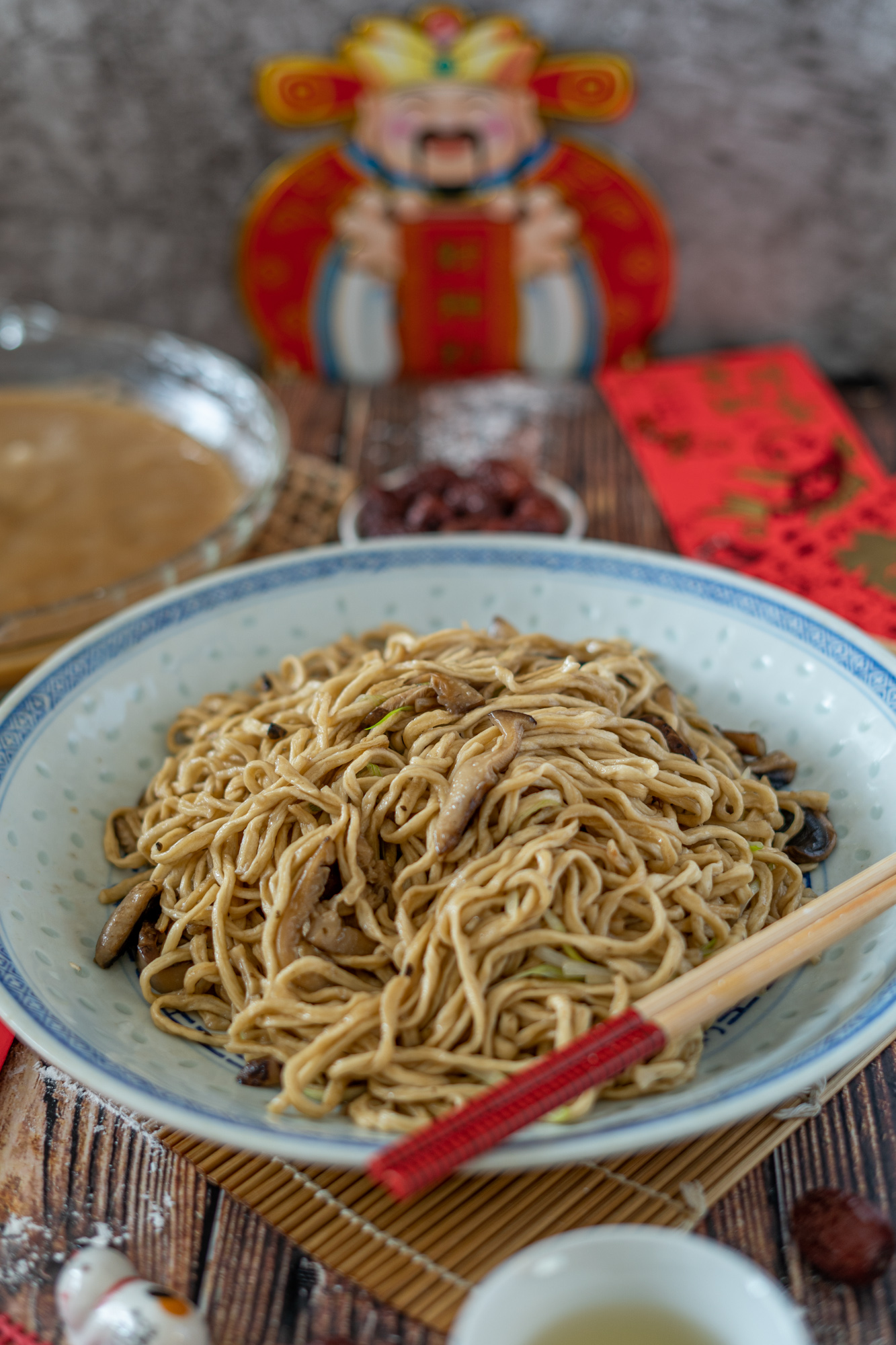
A Whole Fish
On many Chinese New Year tables, it’s fairly common to see a whole fish on display (head, tail and all!), usually steamed to perfection.
Why fish? Well, the Chinese word for fish sounds a lot like a word that means surplus or excess, which is why fish is another Chinese New Year food commonly eaten for auspiciousness and wealth.
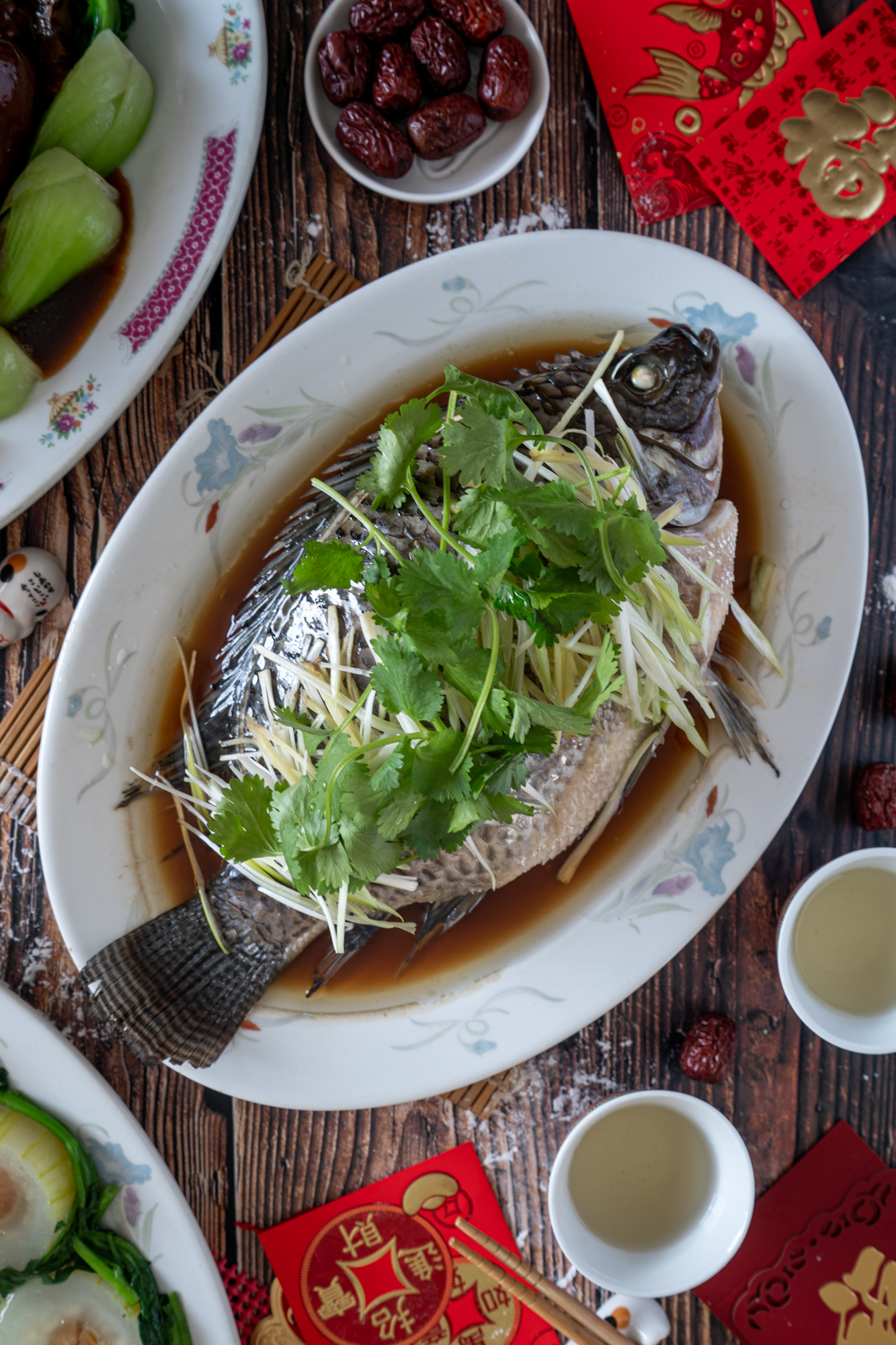
Chinese New Year Recipes to Try at Home
Looking to DIY your own Chinese New Year food? Here is a selection of Chinese New Year recipes created by Papa G to help you have the perfect New Year’s feast at home!
Pork and Chive Dumplings
Dumplings are a quintessential Chinese New Year food, and if you’re looking for a classic foolproof filling, then this pork and chive dumpling is one to add to your list!
Check out our full Pork and Chive Dumplings recipe for step by step instructions.
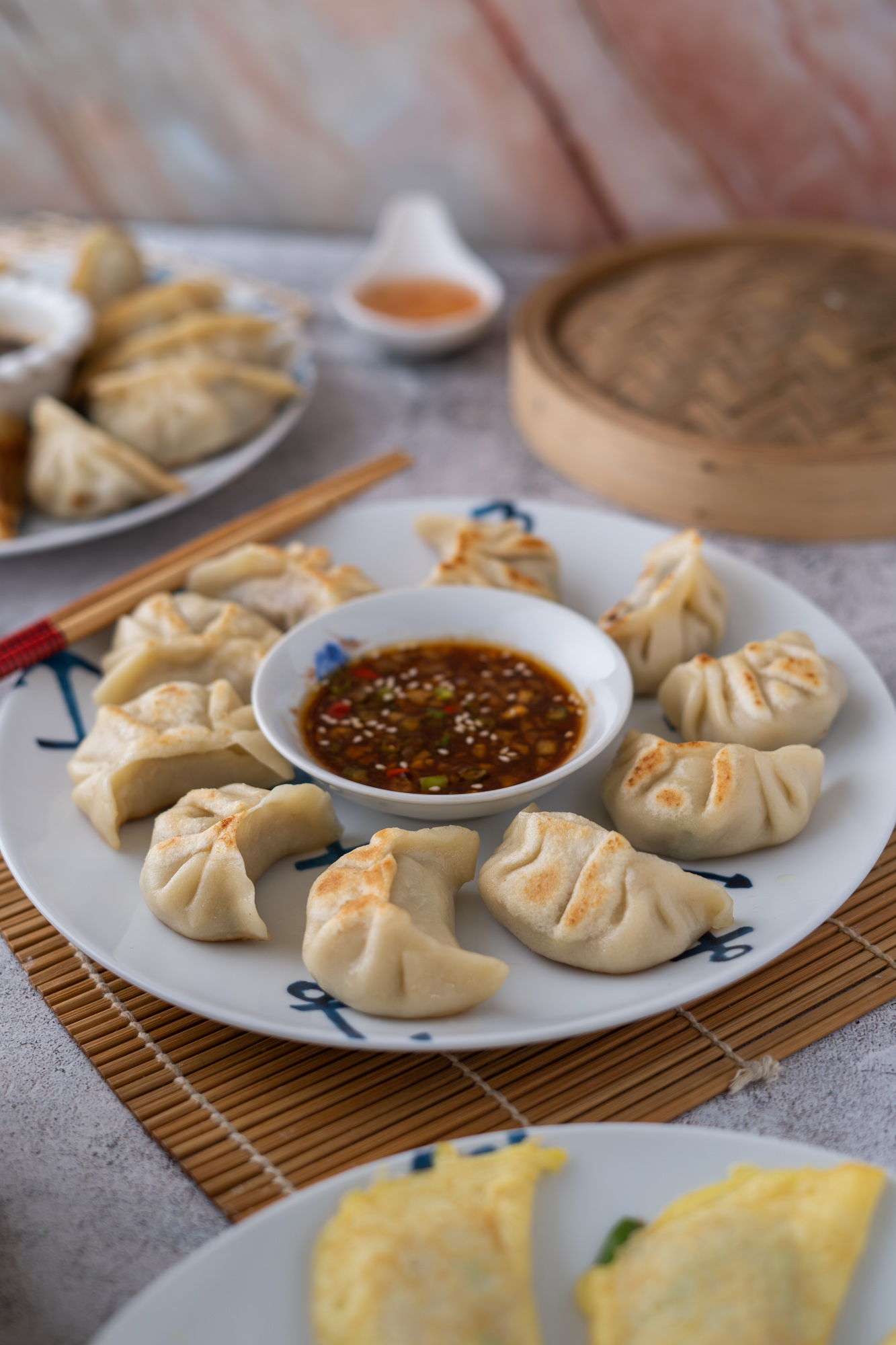
Vegan Dumplings
If you want all the future wealth promised by dumplings, but without any meat, then these plant-based vegan-friendly dumplings are a must-make this Chinese New Year.
Check out our full Vegan Dumplings recipe for step by step instructions.
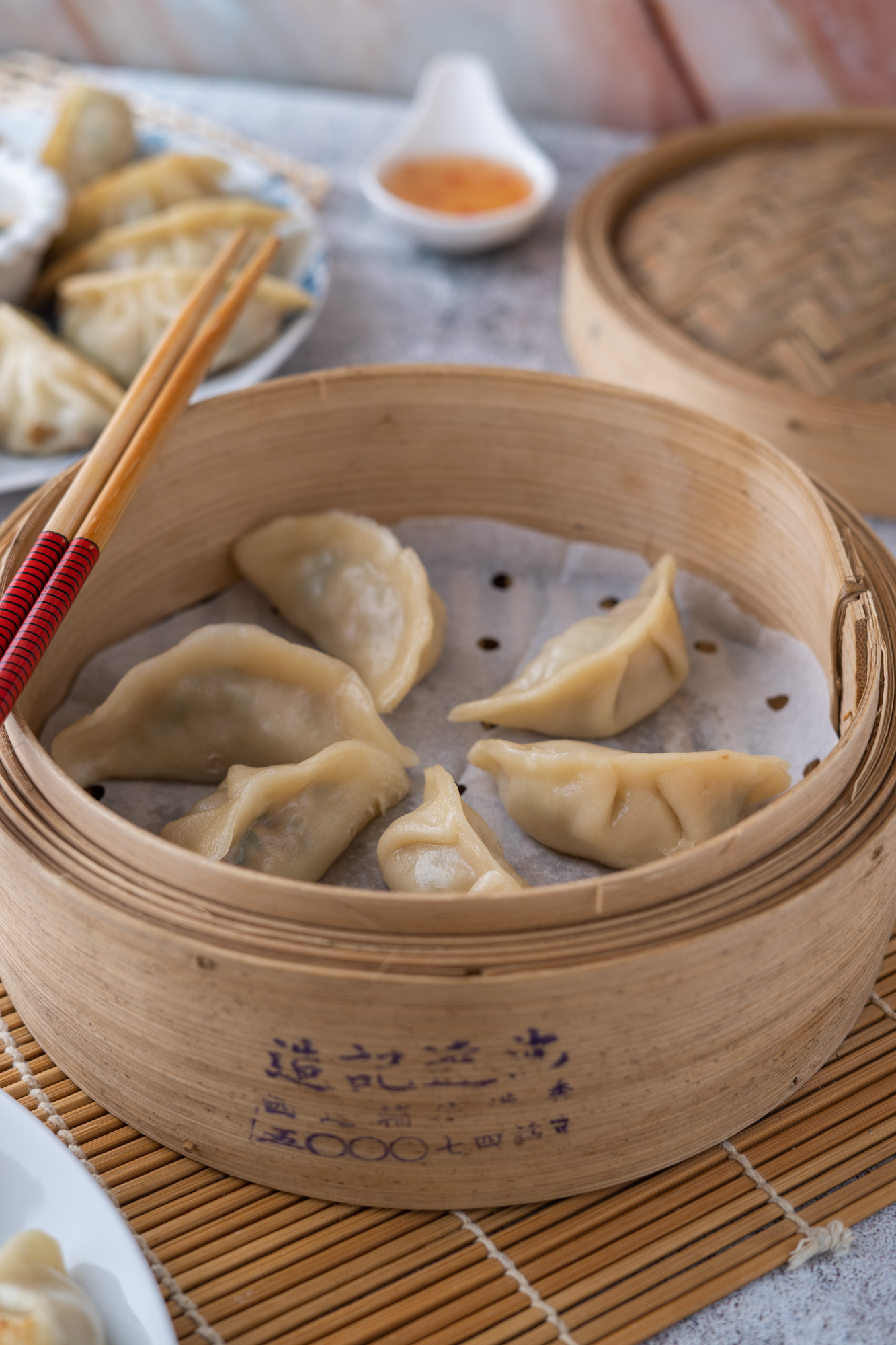
Egg Dumplings
Looking for a low-carb Chinese New Year food? How about some dumplings with an egg wrapper in place of the usual flour-based ones?
Whether bathed in soup or enjoyed on their own, these egg dumplings are a true wealth of flavor.
Full recipe coming soon.
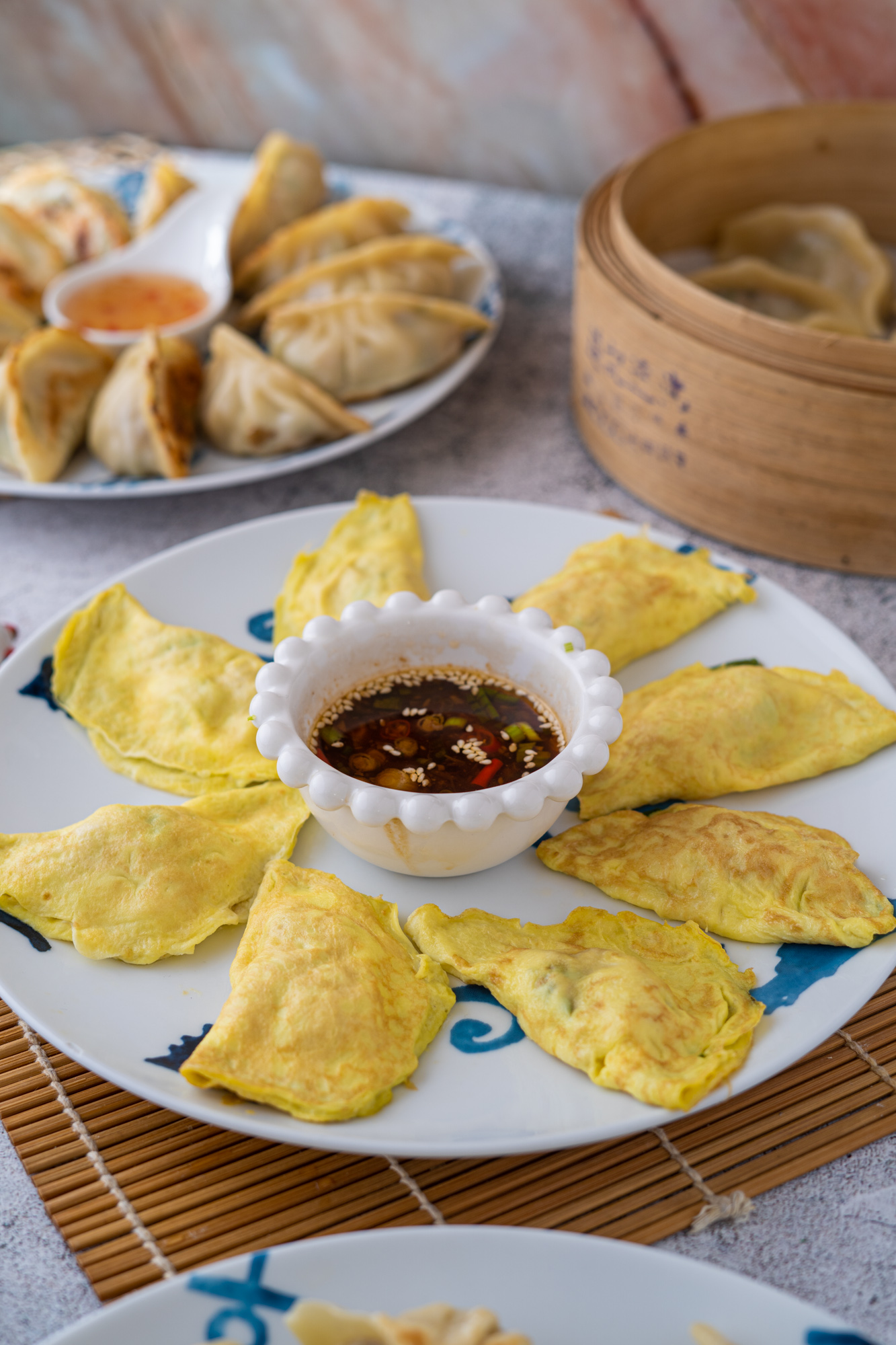
Seafood Spring Rolls
Resembling gorgeous bars of gold, these seafood spring rolls are a delicious treat perfect for Chinese New Year.
Consisting of a succulent seafood and mayo filling, all encased in a crispy dough wrapper, these spring rolls are sure to bring you plenty of joy and fortune for the New Year.
Check out our full Seafood Spring Rolls recipe for step by step instructions.
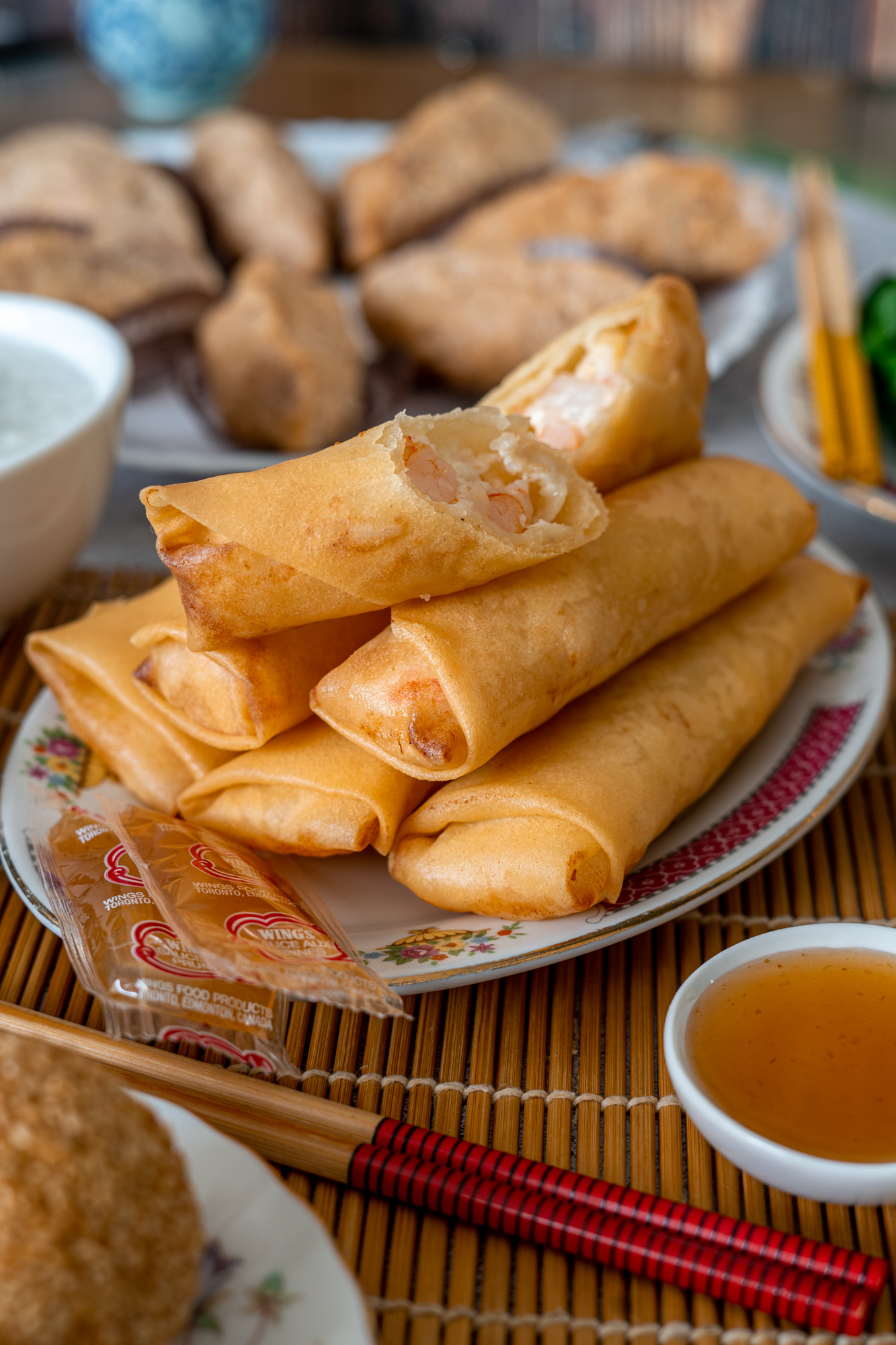
Vegan Spring Rolls
For an indulgent yet vegan Chinese New Year food, these vegan spring rolls are sure to be a hit.
With a flavor-packed filling consisting of cabbage, onions, carrots, and celery, these spring rolls are an irresistible (and lucky!) addition to any Chinese New Year spread.
Check out our full Vegan Spring Rolls recipe for step by step instructions.
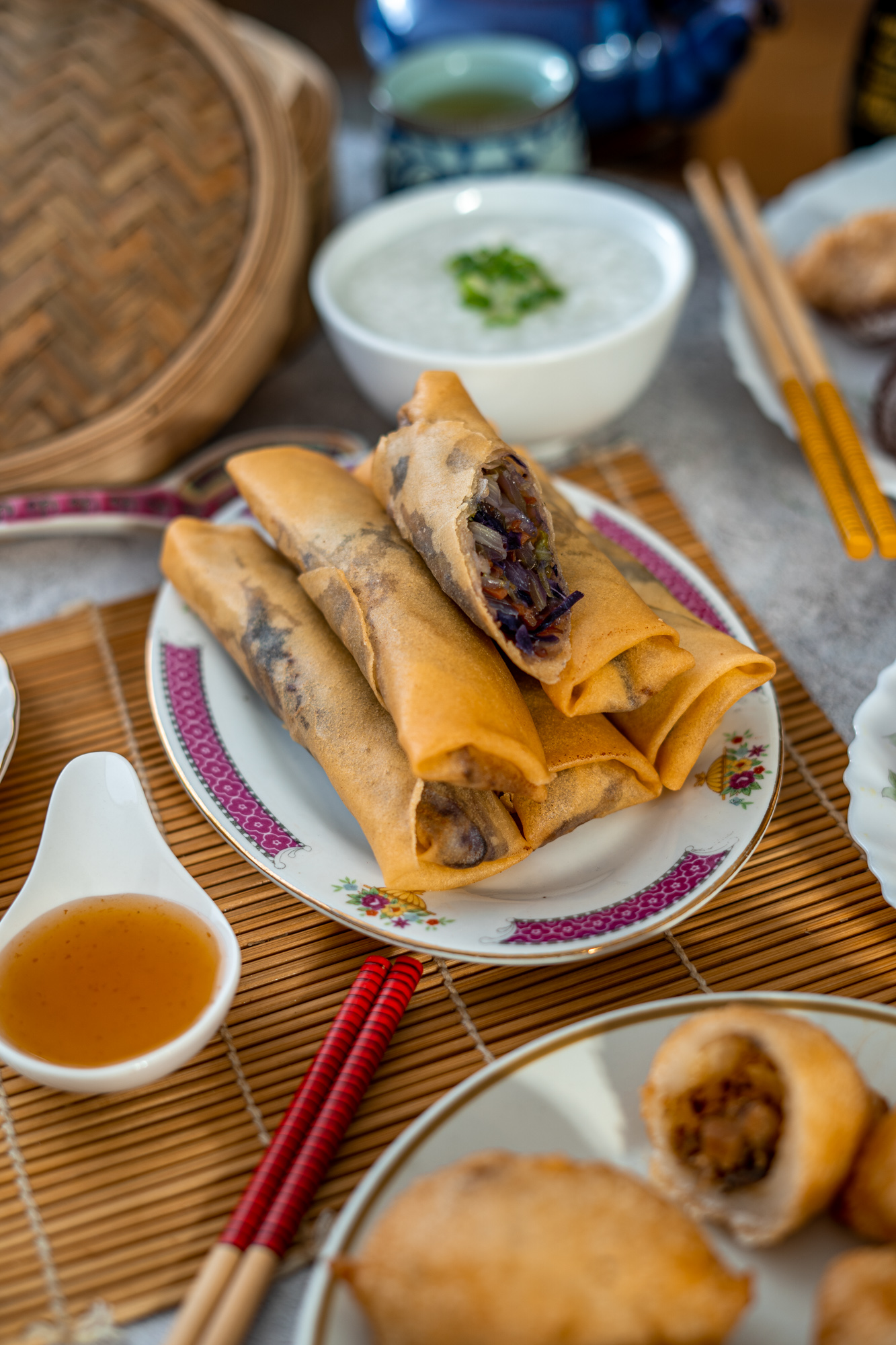
Longevity Noodles (Yi Mein)
Long noodles are a symbol of long life, and no noodle dish quite captures the importance of this more than Longevity Noodles, a staple dish for birthdays and celebratory occasions, including of course, Chinese New Year.
This banquet style Longevity Noodles recipe is based on a common dish served at multi-course Chinese banquets, usually at the tail end of the meal to ensure everybody is stuffed full. Studded with mushrooms and greens, this noodle dish may look simple, but it’s packed with umami and perfectly slurp-worthy noodles.
Check out our full Longevity Noodles (Yi Mein) recipe for step by step instructions.
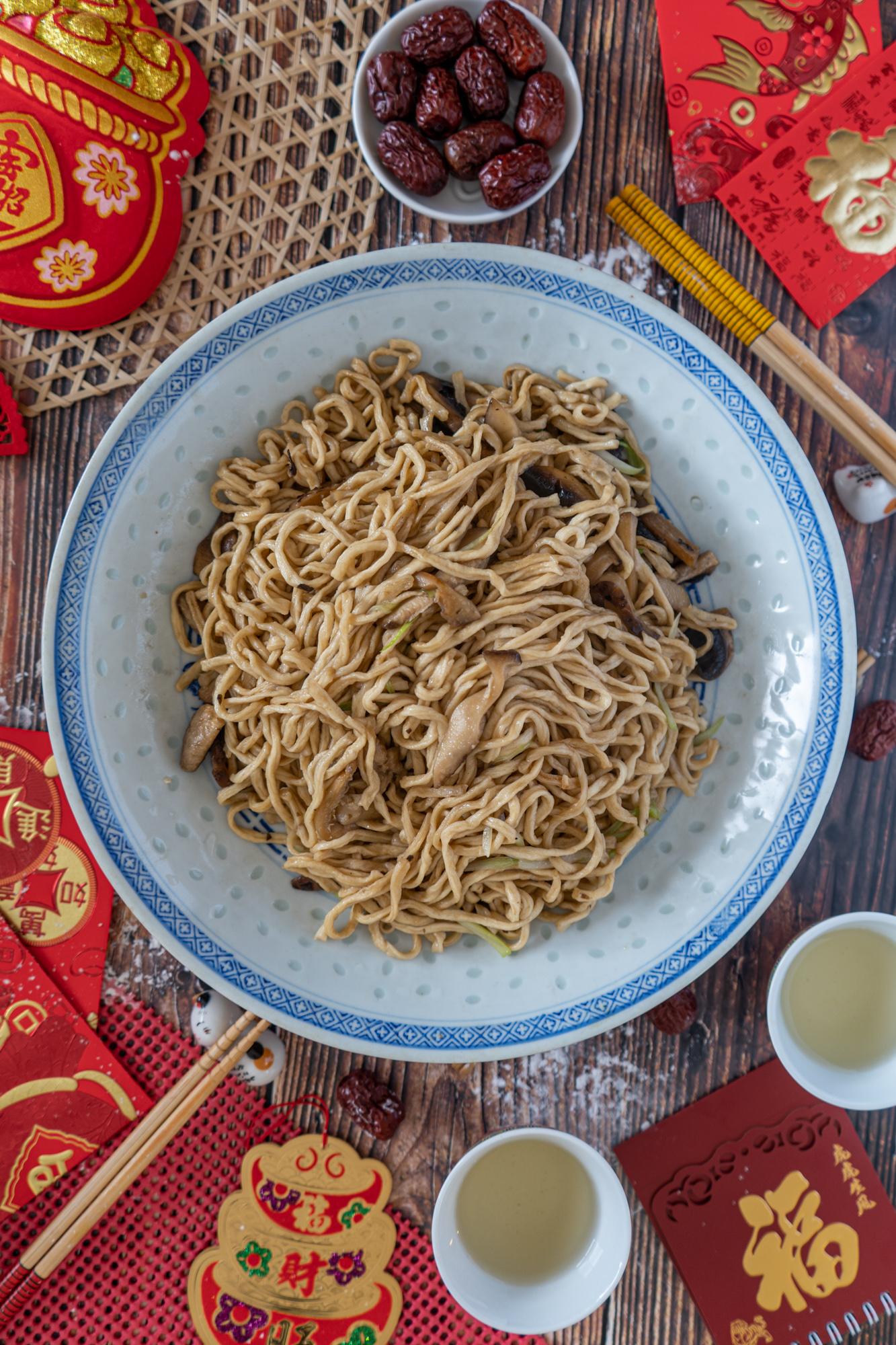
(Savory) Nian Gao
For delicious rice cakes that you can enjoy as a savory main course, then stir-fried Shanghai style Nian Gao are a must-try!
This is a crowdpleasing dish that includes all the components of your standard stir fry (mixed veggies, savoury meats, an an umami-packed sauce), but with the bonus addition of chewy rice cakes instead of standard noodles or rice.
Perfect for mixing things up, and of course bringing on many positive ‘increases’ for the next year.
Check out our full Shanghai-Style Stir Fried Rice Cakes recipe for more info.
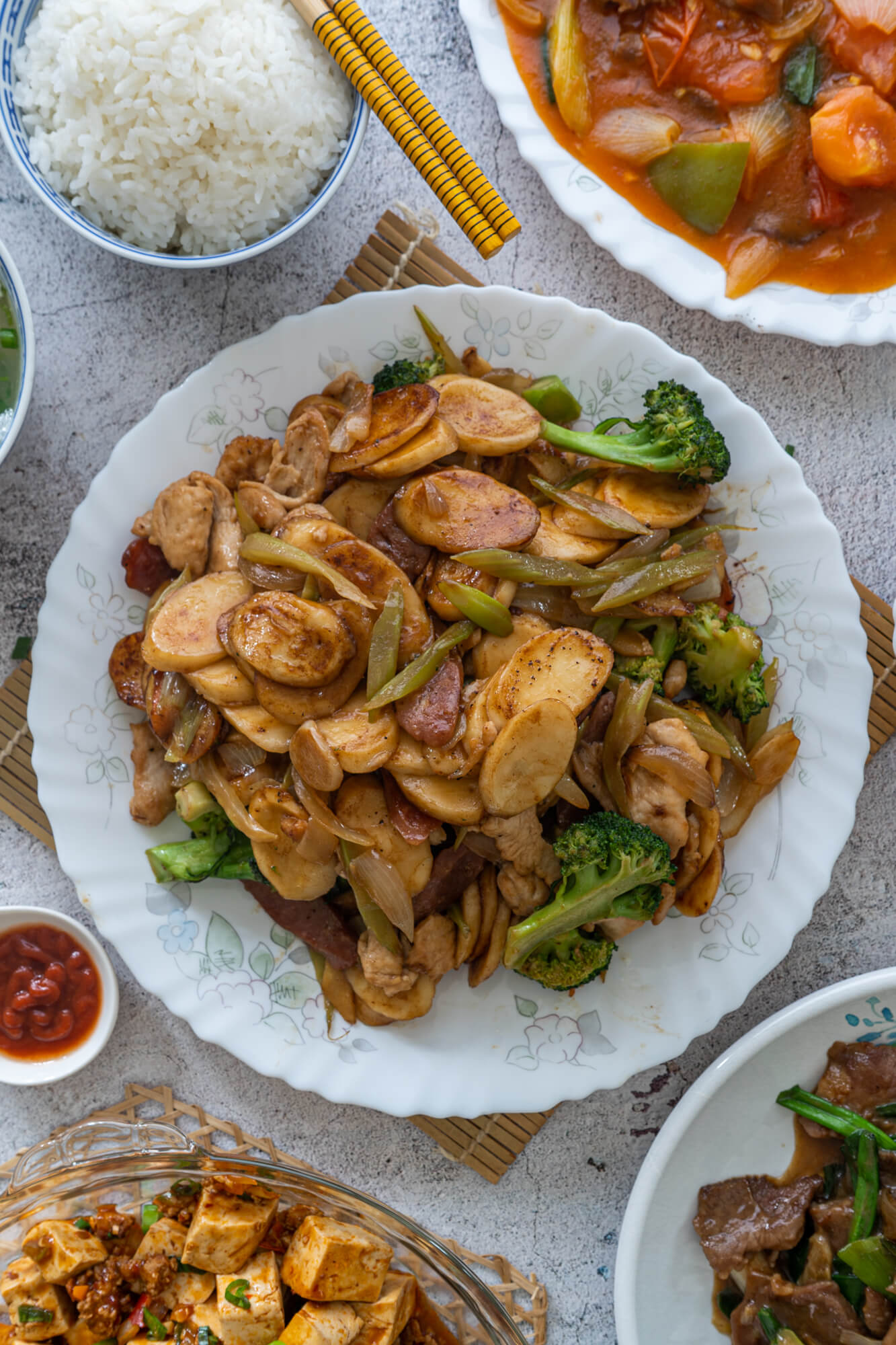
Lion’s Head Meatballs
Despite the name, Lion’s Head Meatballs contains zero lion, and are in fact a delicious Chinese New Year’s dish made of braised pork meatballs that slightly resemble Chinese lions. Thanks to their unique look and shape, they are said to symbolize strength and family unity, hence why they’re a popular New Year food.
These meatballs are hearty and delicious, with a meaty base that’s perfectly seasoned, deep fried, then braised in a beautiful soy-based sauce.
The ultimate finishing touch is of course the thickened gravy (made from the braising liquid) which is liberally poured over the final product, drenching the meatballs and all your veggie garnishes in pure perfection.
Check out our Lion’s Head Meatballs recipe for more info.
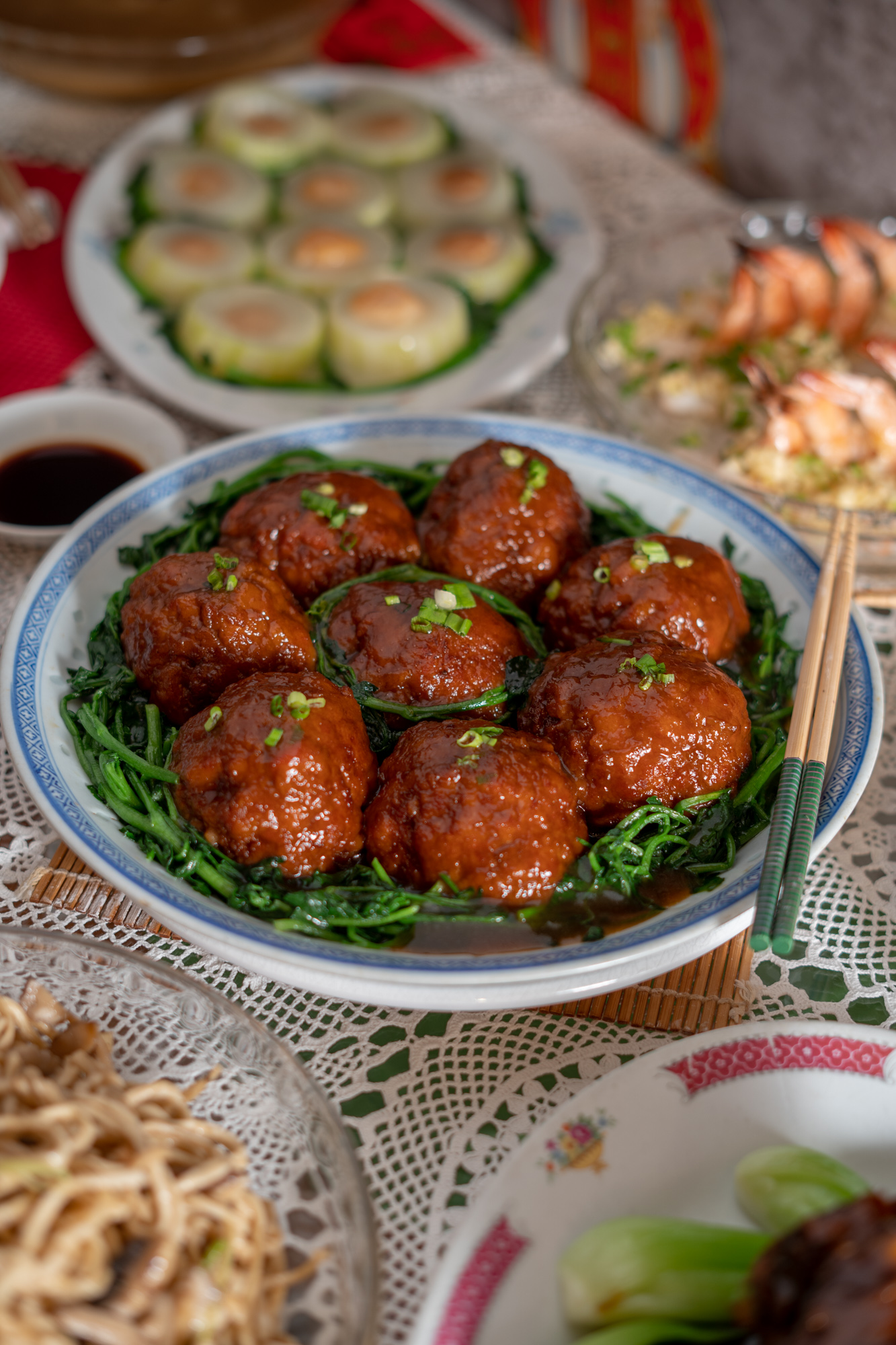
(Whole) Steamed Fish
As mentioned above, the Chinese word for fish sounds very similar to a word meaning surplus or excess, which is why whole fish are a super common Chinese New Year food.
All in the name of auspiciousness and wealth, you know?
Luckily, steamed fish is actually super easy to prepare at home with minimal ingredients… meaning you can have a showstopping addition to the dinner table with minimal fuss.
In this recipe, Papa G uses aromatics like ginger and green onion to bring out the natural flavors of the fish, creating a simple but delicious final product!
Check out our full Chinese Steamed Fish recipe for more info.
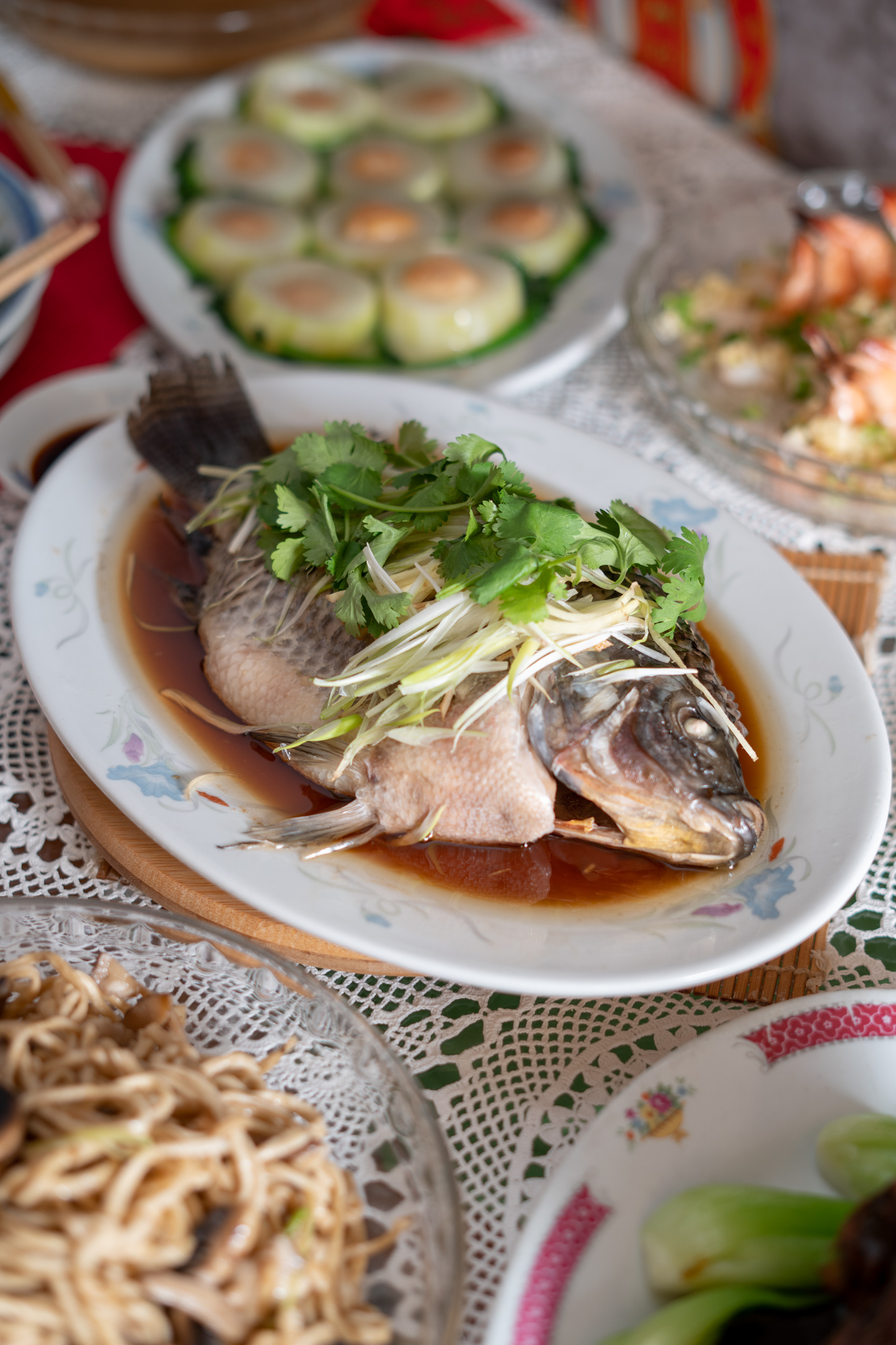
Steamed Garlic Prawns with Vermicelli
Another showstopping dish to serve at Chinese New Year is the almighty Steamed Garlic Prawns with Vermicelli.
Made with succulent prawns steamed to perfection over a bed of slurpworthy vermicelli, guests won’t believe how quickly you whipped this one up, especially if you use Papa G’s neat presentation tricks.
As a bonus, Cantonese households like ours believe that shrimp/prawns bring happiness and good fortune, since the Cantonese word for shrimp is “ha”, like ha ha ha what a wonderful excuse to eat shrimp!
Check out our full Steamed Garlic Prawns with Vermicelli recipe for more info.
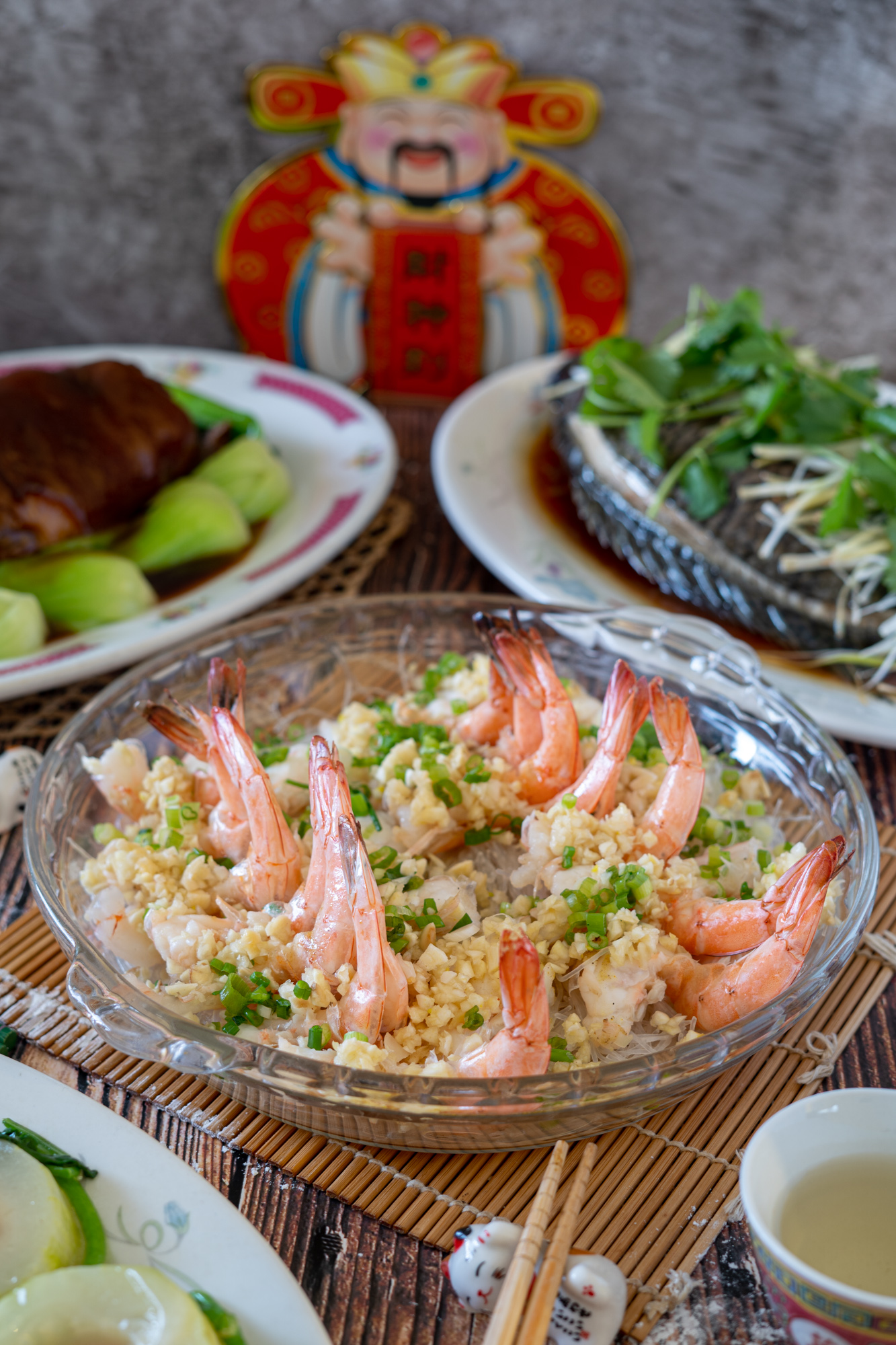
Fuzzy Melon with Dried Scallops
While its name doesn’t translate well, Fuzzy Melon with Dried Scallops is another delicious Chinese New Year food that symbolizes wealth.
Why? Dried scallops are said to resemble old Chinese coins. Yay, more money!
In this recipe, fuzzy melons are hollowed out to make space for a small scallopy coin, then steamed and drizzled with a rich sauce that makes for a delicious and unique final product.
Check out our Fuzzy Melon with Dried Scallops recipe for more info.
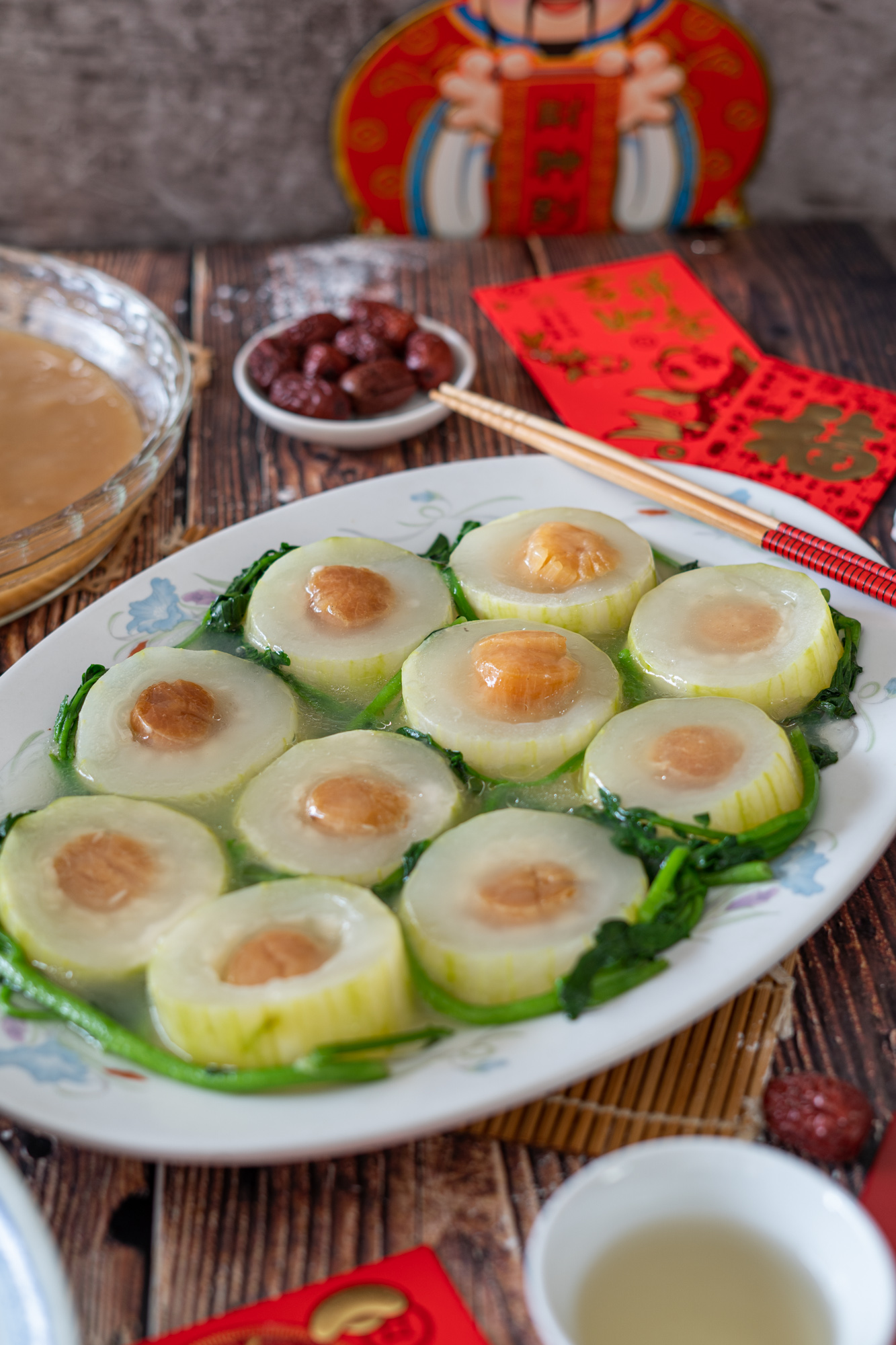
Braised Pork Hock
Pork is often considered a lucky food to eat during Chinese New Year thanks to its fattiness, which is synonymous with prosperity.
Braised pork in particular is considered incredibly lucky, thanks to its reddish color (which of course, as you know, is THE luckiest color out there).
Luckily for us, braised pork is also incredibly delicious, especially with Papa G’s recipe.
Check out our Braised Pork Hock recipe for more info.
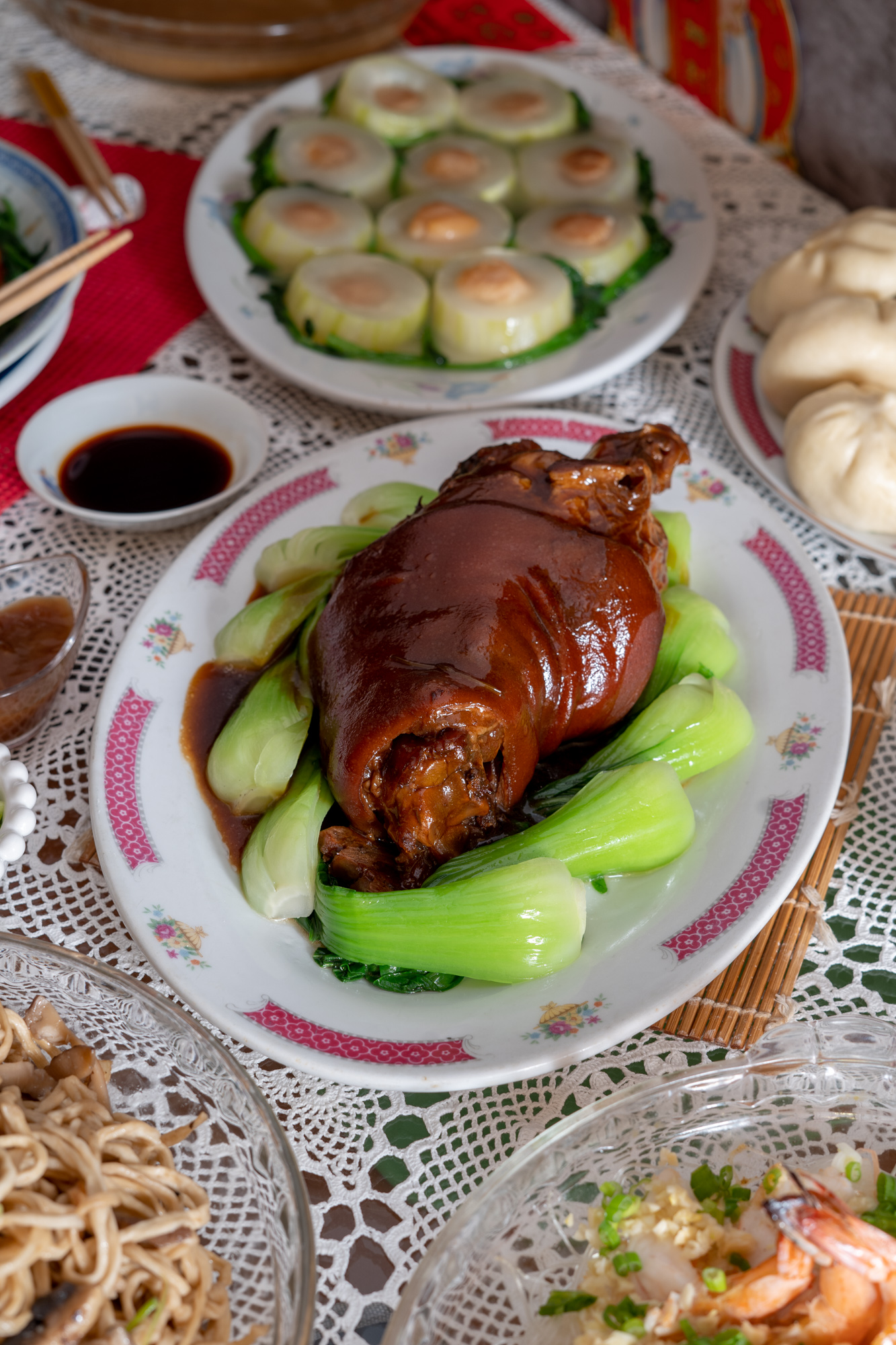
(Sweet) Nian Gao
One of the most popular sweet dishes served at Chinese New Year is sweet Nian Gao. It’s a simple dessert made up of glutinous rice flour, sugar, and water, but the results are perfectly chewy, delicious and oh so satisfying.
My personal favorite way of enjoying nian gao? Slice it up and fry it with some egg. The result is perfect!
Check out our full Sweet Nian Gao recipe for step by step instructions.
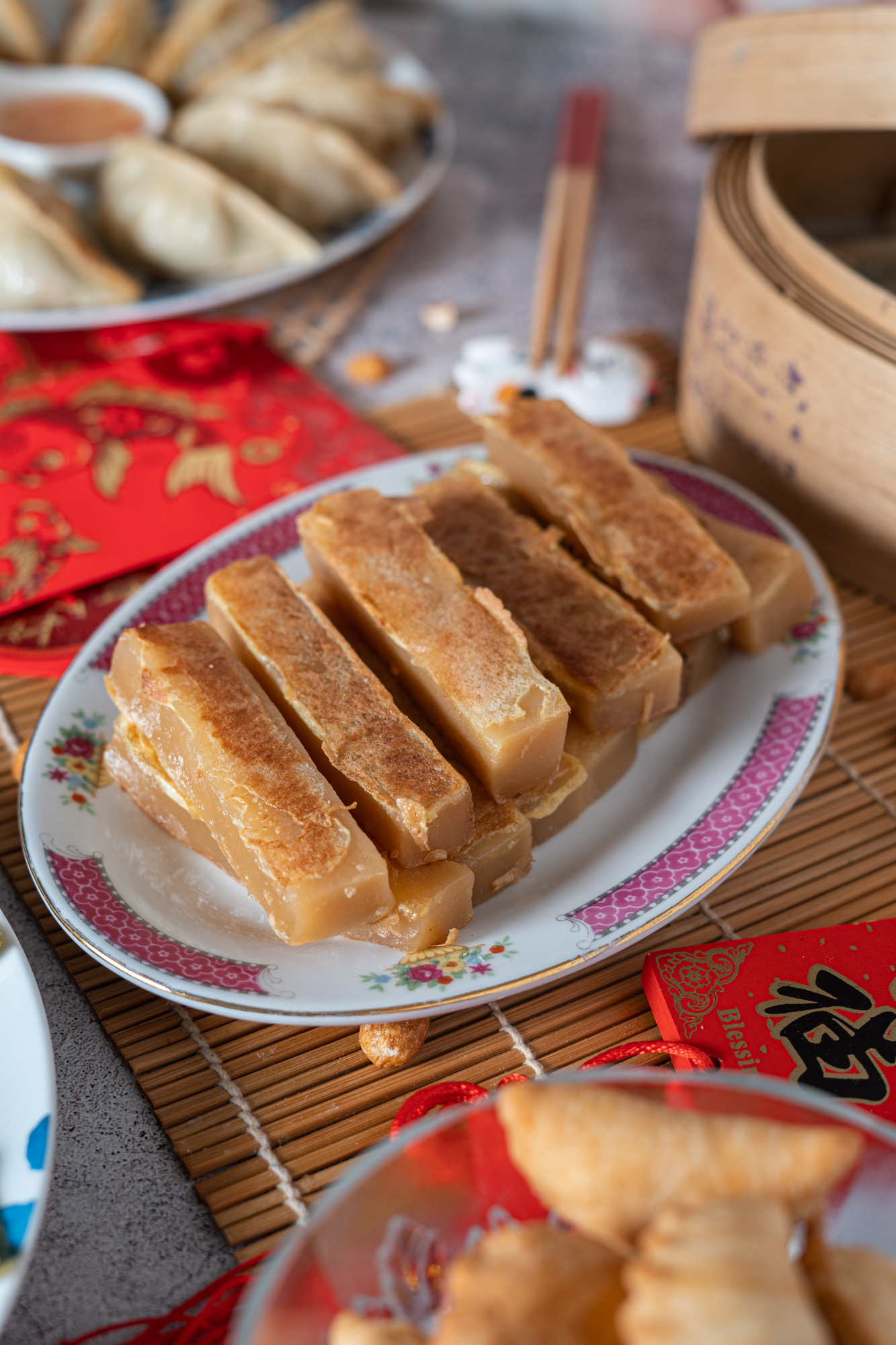
Deep Fried Sesame Balls
Fried sesame balls are a beloved treat consumed en masse at dim sum tables and Chinese bakeries year-round, but they become especially popular during Chinese New Year thanks to their reputation as a lucky food.
What makes sesame balls so lucky? Well, apparently their golden color and round shape signify luck and fortune, while the way they expand while frying is a sign of growth and increasing returns (a common theme during this time of year).
Made up of a glutinous rice flour wrapper that’s coated in sesame seeds and then deep fried, the result is a treat that’s crispy on the outside, chewy on the inside, and usually filled with a tasty filling of red bean or lotus paste.
Check out our full deep fried sesame ball recipe for more info.
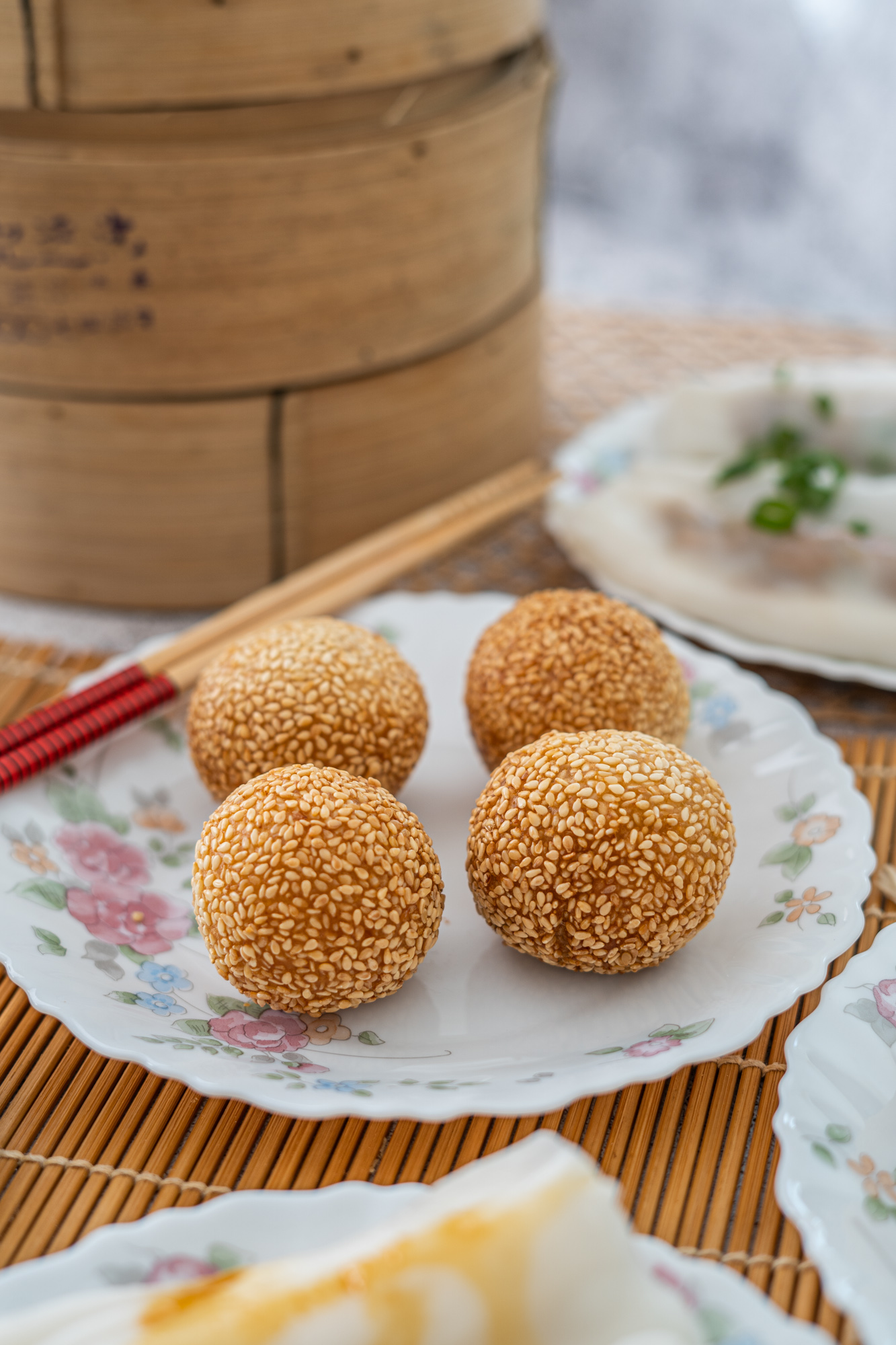
Black Sesame Tangyuan
When it comes to delicious Chinese New Year desserts, few can beat the amazing Black Sesame Tang Yuan, made up of soft, chewy spheres of dough filled with a dreamy black sesame filling.
These amazing treats are usually consumed during the Lantern Festival which takes place on the last day of Lunar New Year festivities.
Check out our full Black Sesame Tangyuan recipe for more details.
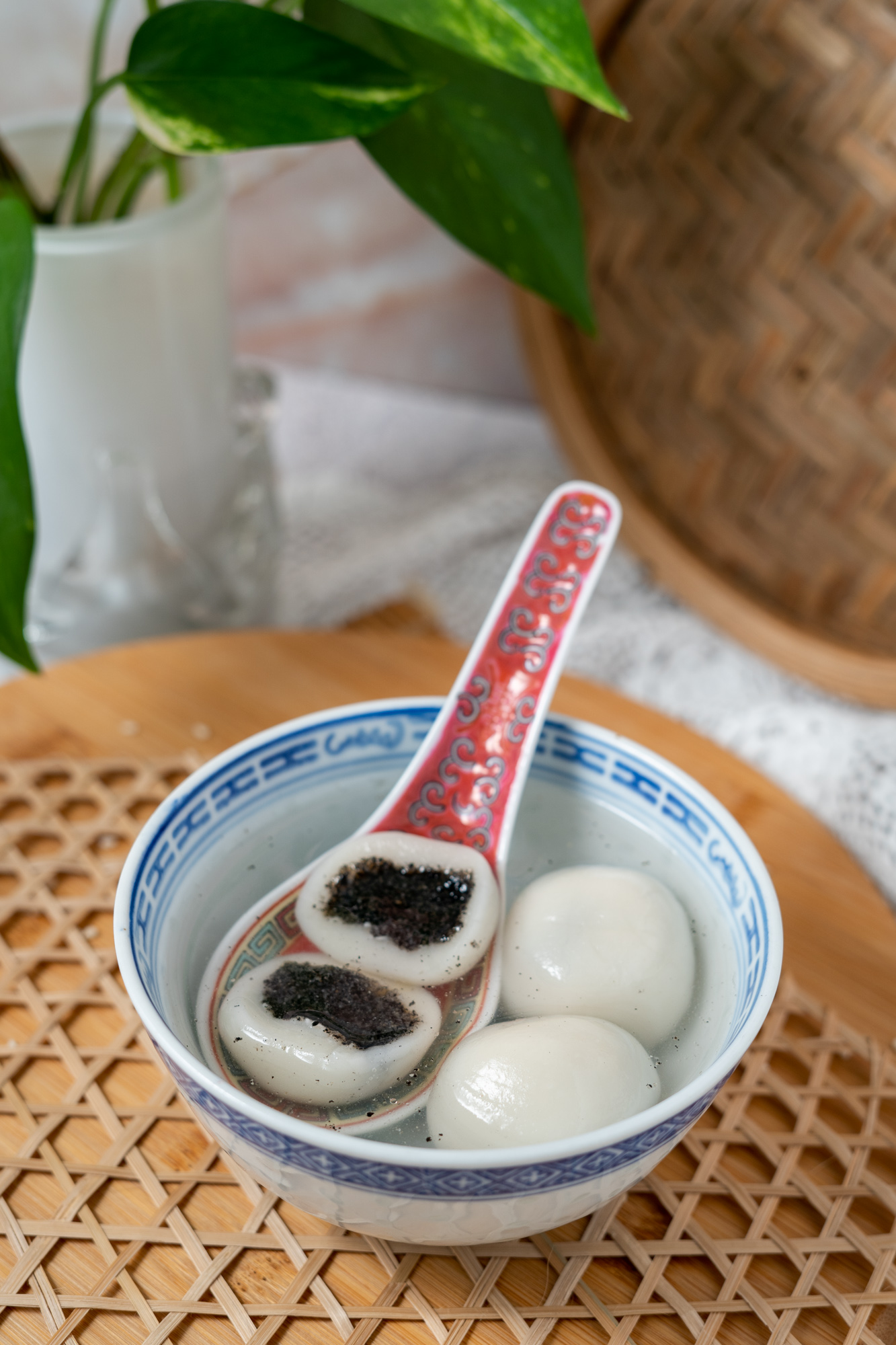
Gok Zai
Full recipe coming soon.
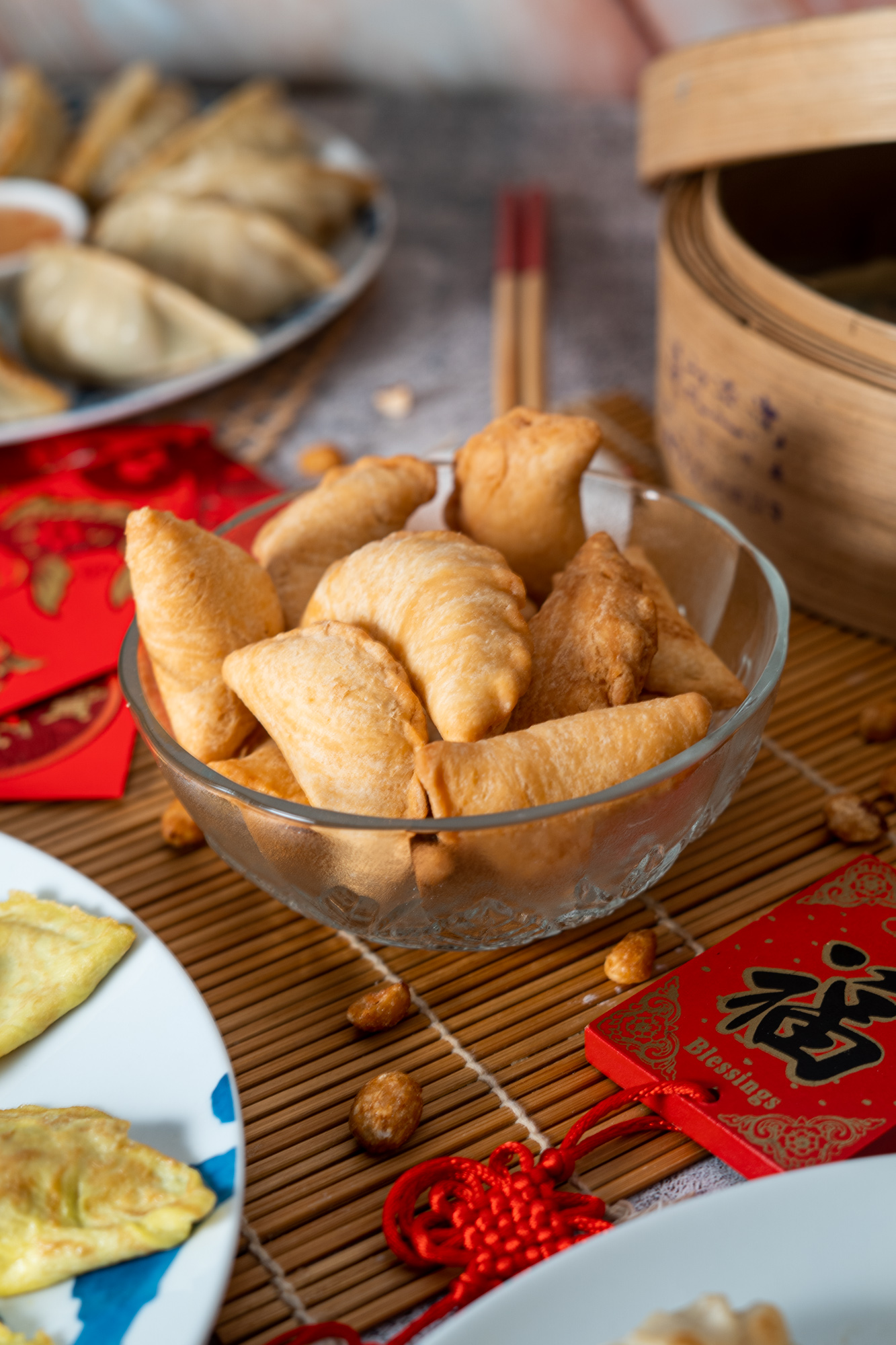
Did we miss any of your favorite Chinese New Year recipes?
Let us know in the comments!